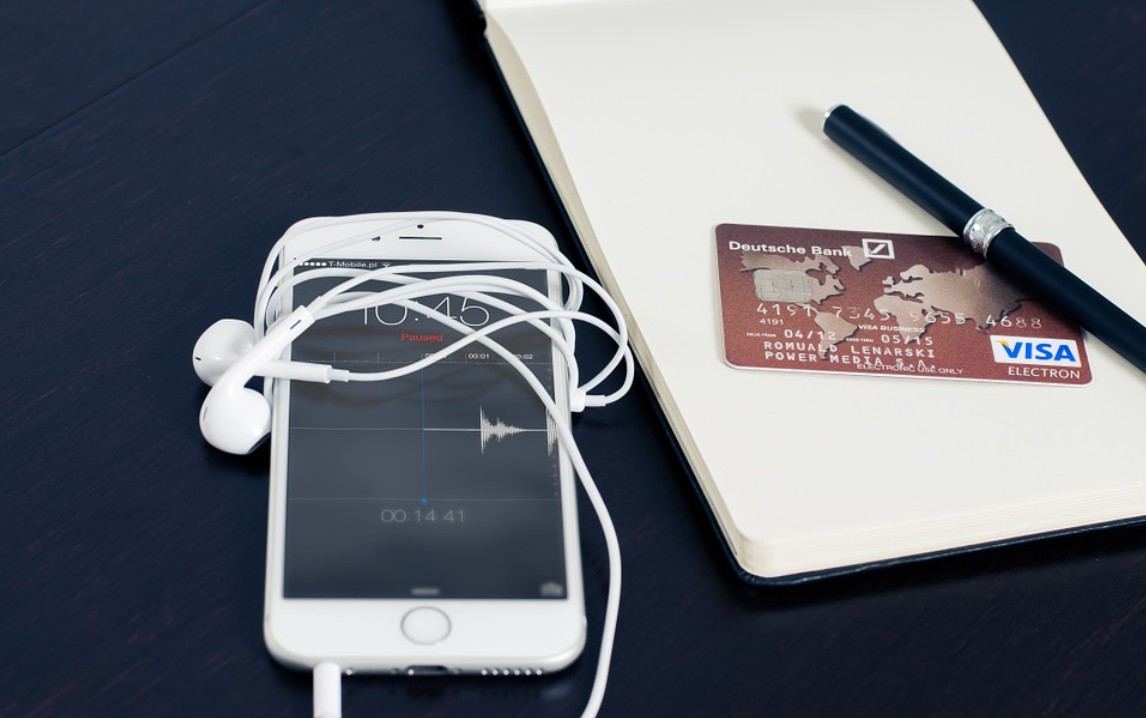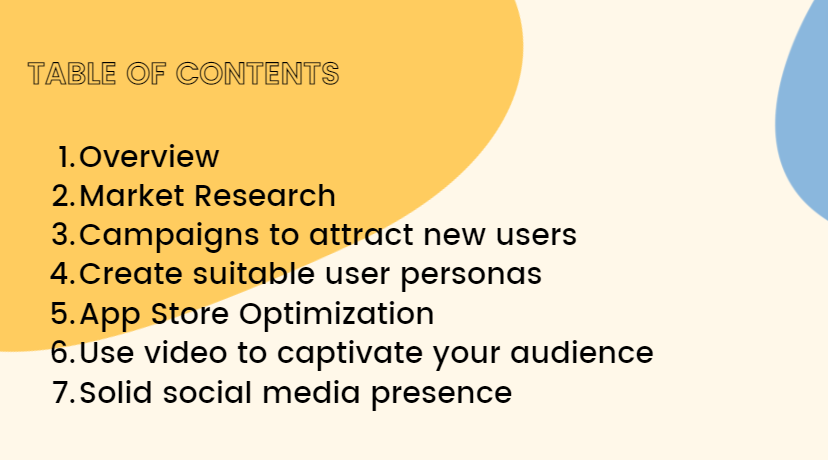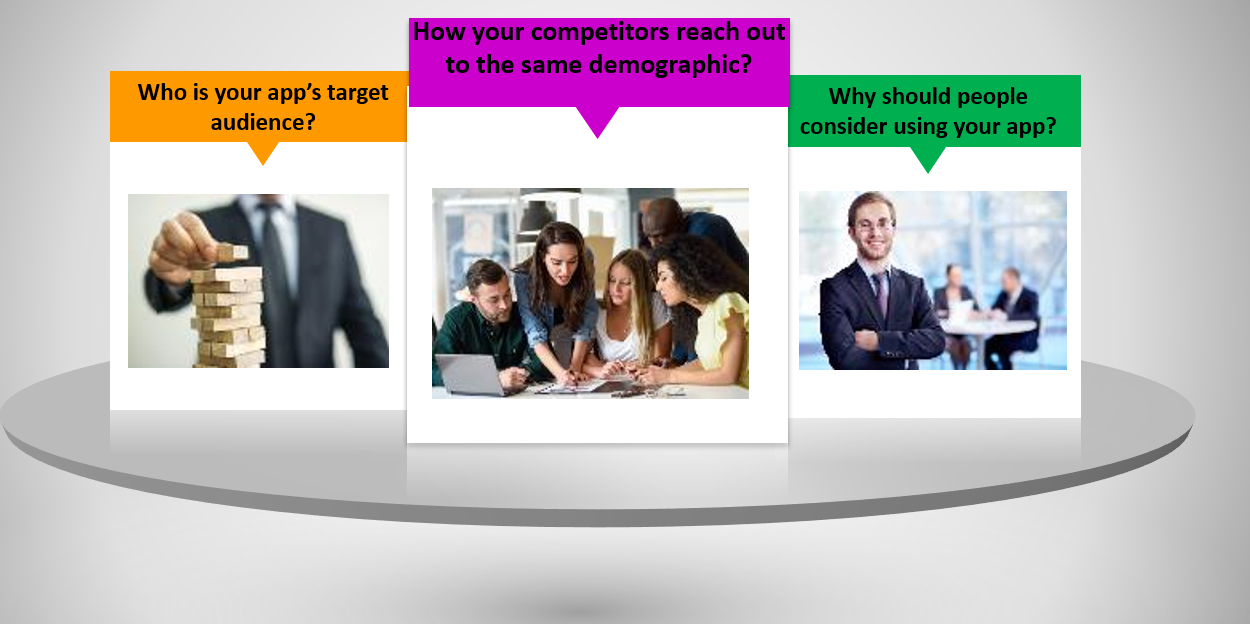
To design your overall plan, you must first understand how you might sell your app. As a result, you will have a better idea of how these tactics might be used to create a great app marketing plan.

Mobile app marketing encompasses all of their interactions from the moment users get to know about a product until they become a committed user. Defining your target customer base, communicating with them, determining the methods to reach them, and evaluating their in-app activity to make continual changes as customers travel through the acquisition funnel are all part of efficient app marketing. Finally, the objective of a mobile app marketing plan focuses mainly to attract users who would engage with the product again and become dedicated advocates.
This Step-by-step guide to mobile app marketing strategies and the metrics to track to achieve long-term success.
Market Research
Market research will assist you in gaining a better grasp of how to employ the app marketing strategies discussed in this tutorial. To facilitate a journey of discovery through significant market research, you must be capable of answering questions early in the design process:

This data should also help you figure out when the best time is to launch your app.
User personas are a clever method to create a mobile app marketing strategy for your specific target audiences. Each user persona represents a subset of people that are expected to follow a specific path. As an app marketer, you should meet their requirements and streamline the process. Demographics, mobile preferences, and other unique identifiers related to your app vertical are segmented to create a user profile. Having a thorough grasp of this will be critical to the success of your app, as it will guide you further down the road and ensure that you make research-based decisions.
Campaigns to attract new users
Customer acquisition is the process of acquiring new users for your app through organic or paid advertisements. You will need to set up campaigns and tweak your ad spend over time with this method for the best results. It’s critical to understand the types of customers you want to attract and the in-app behaviors you want them to take.
You’ll need to observe data and discover trends in client behavior while reviewing the performance of your campaigns and changing your expenditure for better outcomes in the future. By recording how many people did each activity, your attribution provider will assist you in measuring these results. Highlight the best-performing channels in reports. If you have multiple apps, you can cross-promote them to act as both a publisher and an advertisement.
Create suitable user personas
The key goal of the awareness stage is to discover who your consumer is, what they value, and the significant pain problem they suffer that your product will treat. A mobile app can have several user groups, and each customer persona will have its user journey.
A customer persona is a fictionalized version of your ideal customer. The demographics, background, mobility preferences, hobbies, and unique identifiers of a user are all included in user personas. User personas also handle the user’s primary goals and the present issues they confront. In-depth user personas serve as the cornerstone for user journey design, allowing you to tailor each aspect of your mobile product to the tastes and needs of each of your consumers. Everything about your app, from the branding and in-app content to the functionality, features, platform selection, and monetization plan, must appeal to your target customer. You’ll be able to answer critical questions that will guide your whole marketing approach by thoroughly describing your target demographic with user personas.
Read here how appICE can help in creating user persona
Consider the following scenario:
- What is the primary source of pain for this audience as a whole?
- What operating system does this audience utilize on their mobile device? Which is better, iOS or Android?
- What kinds of online content does this audience enjoy?
- Is there any visual branding that emerges from this audience’s internet activity?
- What are the best tone, voice, and content styles for this audience?
- Are there any recognized influencers in this product’s niche that these users follow on social media?
- What are the best platforms to use for sponsored advertising?
- Is it common for these consumers to pay for apps or make in-app purchases?
Personas can assist you in integrating design, marketing and business decisions to attract the correct audience to your product by answering questions like these. You won’t be able to produce a product appropriate to their demands if you haven’t thoroughly researched your audience?
Also Read – Customer Data – A marketer’s guide for flawless customer data orchestration
App Store Optimization
App store optimization is critical for your app to stand out among the Apple App Store’s more than two million apps. Your app’s listing must be optimized to appear at the top of a search result in the app store, just like you optimize your website to rank on a search engine results page. The higher you rank, the more prospective new users will be exposed to you.
Use video to captivate your audience
By 2020, the video will have surpassed text as the most popular type of content, accounting for a minimum of 80% of all user internet traffic. Create films for YouTube, Instagram, and Facebook that you (and your users) can share. Incorporate excellent video strategy, which includes video briefs, descriptive, and understandable even when on mute.
Videos may be anything from app tutorials to information that helps customers get to know your brand, like what you offer and how you help them solve problems. Keep the movies short, no more than 60 seconds, and ensure the call to action is clear even if the audio is turned off.
Solid social media presence
You must be active on social media if you want to get noticed. Additionally, social media can offer you helpful information about your users to increase your app’s visibility. To fine-tune your advertising campaign interests, learn about their hobbies, demographics, when they’re most active, and more.
Engaging with your users is essential when it comes to integrating your social media campaign, but resharing their material is even better. Airbnb consistently publishes user-submitted photos and interacts with its fans in the comments section. Demonstrate how others are using your app and initiate actual discussions with them.
No Comments